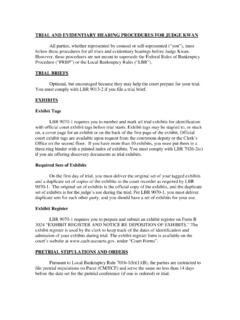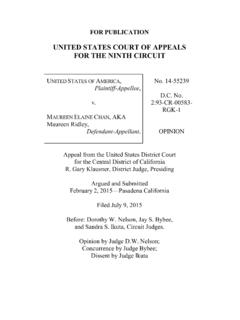Transcription of A Modern History of Taekwondo
1 "A Modern History of Taekwondo " written by KANG Won Sik and LEE Kyong Myong Translated from the original korean book to english by Glenn U. And studens. Special thanks goes to Glenn U. for providing this portion on the History of Taekwondo , Glenn's contribution and support to Taekwondo , Jidokwan and the World jidokwan Federation is fully appreciated. The information on this page is copyright protected and considered the property of the WJDKF and the Taekwondo leaders that provided said information to the WJDKF. INDEX Chapter 1: The Development of the Kwans Chapter 1, Section 1: Chung Do kwan Chapter 1, Section 2: Choson Yun Moo kwan Kong Soo Do Bu (Jidokwan) Chapter 1, Section 3: Moo Duk kwan Chapter 1, Section 4: YMCA Kwon Bup Bu (Chang Moo kwan ) Chapter 1, Section 5: Song Moo kwan Chapter 1, Section 6: Oh Do kwan Chapter 1, Section 7: Kang Duk Won Chapter 1, Section 8: Han Moo kwan Chapter 1, Section 9: Jung Do kwan Chapter 2: The process of Association unification is full of ups and downs Chapter 2, Section 1: Independence of August 15, 1961 and the process of Association unification Chapter 2, Section 2: The Korean War and the Korea Kong Soo Do Association Chapter 2, Section 3: The newly established Annex Kwans holding their own and the subsequent unification efforts Chapter 2, Section 4: Choi Hong Hi and the 1959 Korea Taekwondo Association Chapter 2, Section 5.
2 Hwang Kee and the Korea Soo Bahk Do Association Chapter 2, Section 6: The 1961 Unification Conferences and the different perspectives of the kwan leaders Chapter 2, Section 7: The Korea Taesoodo Association: The Entity of Unification Chapter 2, Section 8: The Unification of the Dan Promotion Test and Hyung (Forms) Chapter 2; Section 9: The Founding of the Korea Taekwondo Association Chapter 2; Section 10: Trouble between the First and Second Generations in Taekwondo Chapter 3: The Emergence of Kukki Taekwondo Chapter 3; Section 1: 5th President KIM Yong Chae: Developing Taekwondo Chapter 3; Section 2: 6th President KIM Un Yong: Rehabilitating Taekwondo Chapter 3, Section 3: A Leap in Kukki Taekwondo Chapter 3, Section 4: The Discussion regarding the Elimination of Old Teaching Methods and the Restrictions on kwan Membership Transfer Chapter 3, Section 5: This and That in 1971 Chapter 4: Kukkiwon - The Mother Body of Rehabilitation Chapter 4, Section 1: The Early Steps in Building the Central Dojang Chapter 4, Section 2: Producing Elite Taekwondoin Chapter 4, Section 3: The International Taekwondo Academy Chapter 4, Section 4: The Taekwondo Museum Chapter 4, Section 5: Kim Un Yong's Efforts in Retrospect Chapter 5: The Prosess of kwan Unification Chapter 5, Section 1: The Formation of the Driving Committee for kwan Unification Chapter 5, Section 2: Moving away from the Deep Rooted kwan Rivalries Chapter 5, Section 3.
3 The Aftermath of kwan Unification A Modern History OF Taekwondo This book shows the Modern History of Taekwondo by describing major events and facts and episodes that have not been known to public in Modern Taekwondo society in Korea. It traces the changes and development of Modern Taekwondo up to now: beginning period when various Kwans were created and flourished; period of unification of different Kwans to Taekwondo ; period of development of Taekwondo as a national martial art of Korea; globalization of Taekwondo ; and inclusion of Taekwondo in Sydney Olympic Games as an official sport & continued effort to make Taekwondo as a mandate program of the future Olympics. The book also mentions the meaning and outlines of Poomsae and how Poomsae has become a competition, following Kyorugi. On the other hand, it provides the History of documentary records on Taekwondo over the past 50 years and History of organizations which have been set up for researches on Taekwondo .
4 Mr. Kang worked for the Korea Taekwondo Association, Asian Taekwondo Union and Kukkiwon. Presently, he is a professor of the Department of Taekwondo at Yong-In University and president of Taekwondo Shinmun, a Korean Taekwondo newspaper. Mr. Lee worked at the World Taekwondo Federation after propagating Taekwondo in Europe for over 20 years. He is a professor of the Department of Sports Diplomacy at Choongcheong College and has published many books on Taekwondo . Published in March 1999 by: Bokyung Moonhwasa at 389-22 Seokyo-dong, Mapo-ku, Seoul, Korea 121-210. tel no. 82 2 325 8833/325 7211 fax no. 82 2 325 7213. ISBN 89-358-0124-0. 8,000 won in Korean currency per copy. Chapter 1, Section 1: Chung Do kwan Right after the independence of Korea, the Chung Do kwan , one of the five key Dojangs, was founded first. Its ymbolized Chung Do kwan 's name, Bluewaves, meaning a youngster's spirit and vitality. Chung Do kwan 's founder, LEE Won Kuk, moved to Japan when he was 19 years old in 1926.
5 While in Japan, he first attended middle and high school, and then entered the law school of Chuo University. Then he entered Japan's Karate headquarters, the Song Do kwan (Shotokan). He received Karate instruction from Karate's father, Funakoshi Sensei. There, he learned Karate with Song Moo kwan 's founder, RO Byung Jick. He moved back to Japan and taught Tang Soo Do in the Yong Shin school hall in Suh Dae Moon Gu's Ochun Dong, Seoul because he had a good relationship with Japan's Chosun Governor General Abe in 1944. This led to the rumor that he was pro-Japanese. Later, Oh Do kwan 's founder, CHOI Hong Hi said "After independence, LEE kwan Jang was charged with acts of pro-Japanese and stood in a special civil trial." LEE Won Kuk was a precise person. He had a strong body of a martial artist and glaringly sharp eyes. His expression was very strict. Right after the independence day, he seemed to offset his pro-Japanese deeds by developing a good relationship with people of the National Police Headquarters.
6 He led the efforts to get rid of Seoul gangsters. The Chung Do kwan was once called the National Police Headquarters dojang. After the Korean War, the Chung Do kwan members were less than 200. GM LEE Won Kuk visited the school twice and watched the lessons. The primary instructors were YOO Ung Jun and SON Duk Sung, with promotion tests given every six months. Graduates of the Chung Do kwan were: 1. YOO Ung Jun 2. SON Duk Sung 3. UHM Woon Kyu 4. HYUN Jong Myun 5. MIN Woon Sik 6. HAN In Sook 7. JUNG Young Taek 8. KANG Suh Chong 9. BAEK Joon Ki 10. NAM Tae Hi 11. KO Jae Chun 12. KWAK Kuen Sik 13. KIM Suk Kyu 14. HAN Cha Kyo 15. JO Sung Il 16. LEE Sa Man 17. RHEE Jhoon Goo (Jhoon Rhee) 18. KIM Song Sik From Inchon, which became the center of the Chung Do kwan 's annex Kwans, more schools were opened. They were: 1) KANG Suh Chong's Kuk Mu kwan 2) LEE Yong Woo's Jung Do kwan in Suh Dae Moon Ku 3) KO Jae Chun's Chung Ryong kwan in Kwang Ju 4) CHOI Hong Hi's Oh Do kwan The Oh Do kwan especially had active Chung Do kwan members who were in the military after the Korean War.
7 The Chung Do kwan 's first kwan Jang was LEE Won Kuk; the second was SON Duk Sung; and the third was UHM Woon Kyu. When SON Duk Sung because the kwan Jang of the Chung Do kwan , UHM Woon Kyu, HYUN Jong Myun, and NAM Tae Hi had conflicts with regard to the issue of who should receive the nomination from LEE Won Kuk and become the next kwan Jang. Chapter 1, Section 2: Choson Yun Moo kwan Kong Soo Do Bu (Jidokwan) The Jidokwan was founded by an elite member, CHUN Sang Sup, on May 3, 1946 as the Choson Yun Moo kwan Kong Soo Do Bu. When he was a teenager, he learned Judo and learned Karate while studying abroad in Japan. After the Independence Day, he opened the Choson Yun Moo kwan Kong Soo Do Bu at the former Judo school, Choson Yun Moo kwan , where he taught Judo and Karate. He began to recruit new members. He had a slender figure and was not particular, but was an intellect and always wore suits. However, during the Korean War, he vanished, the Choson Yun Moo kwan Kong Soo Do Bu was abolished and it was renamed Jidokwan.
8 After Independence Day, the Choson Yun Moo kwan taught no guep (mu guep) to 8th guep in high, middle and low classes. The student's kwan number was based on guep promotion, and not only the day of the first registration as a student. The Choson Yun Moo kwan was started in Seoul, but the major development and structural growth was spread from Chun Ju, Cholla Buk Do as a center. Then, CHUN Il Sup opened another school in Kunsan, Cholla Buk Do in May 1947, and spread his school's reputation from Jun Joo to Kunsan, I Ri, Nam Won, Jung Uep and more. During the Korean War, the Choson Yun Moo kwan 's name was changed to Jidokwan. After CHUN Sang Sup was kidnapped to North Korea, the Jidokwan (Wisdom Way School) was opened and ran by YOON Kwe Byung and LEE Chong Woo until 1967. However, through the process of unification with the Korea Tae Soo Do Association, the Jidokwan had conflicts between YOON Kwe Byung and LEE Chong Woo.
9 Led by LEE Chong Woo (Jidokwan), LEE Nam Suk (Chang Moo kwan ), UHM Woon Kyu (Chung Do kwan ), HYUN Jong Myun (Chung Do kwan /Oh Do kwan ) and others planned to unify, but YOON Kwe Byung and HWANG Kee (Moo Duk kwan ) declined and persisted on their self testing committee. Jidokwan graduates were: 1. BAE Young Ki 2. LEE Chong Woo 3. KIM Bok Nam; 4. PARK Hyun Jung 5. LEE Soo Jin 6. JUNG Jin Young 7. LEE Kyo Yoon 8. LEE Byung Ro 9. HONG Chang Jin 10. PARK Young Kuen and others. Jidokwan's distinguished difference from other schools was mainly based on Kyorugi (sparring). When Taekwondo tournaments became active from the beginning of the 1960's to the 1970's, Jidokwan distinguished itself. The major representatives were LEE Seung Wan, CHO Jum Sun, HWANG Dae Jin, CHOI Young Ryul and more. Jidokwan's representing annex was the Han Moo kwan . But, LEE Kyo Yoon said hes Han Moo kwan root is not Jidokwan, but rather the Choson Yun Moo kwan . This shows the debate of the origins of the school.
10 Jidokwan's first kwan Jang (grandmaster) was CHUN Sang Sup; the second kwan Jang was YOON Kwe Byung and the third LEE Chong Woo. Chapter 1, Section 3: Moo Duk kwan After Independence Day, the Moo Duk kwan started as the "Transportation by Rail Committee Tang Soo Do Bu" at the railroad system at Yong San Station, Seoul. The Department of Transportation allowed the Tang Soo Do Dojang as a traffic service, but the exact date is unknown. We only know that it was founded after 1946. HWANG Kee claimed that he learned Kuk Sool when he worked for the Southern Manchuria Railroad in 1935, but other Taekwondo seniors denied this claim saying that there was no evidence. Moo Duk kwan was nearby the Yong San Railroad station, so it was called the "Railroad Dojang". The first Moo Duk kwan dan holder was KIM Woon Chang. Others were: 1. HONG Chong Soo 2. CHOI Hui Suk 3. YOO Kwa Young 4. NAM Sam Hyun 5. KIM In Suk 6. LEE Bok Sung 7. HWANG Jin Tae 8. WON Yong Bup 9.



















